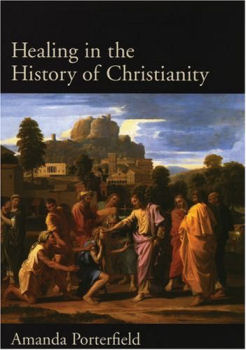
|
Posted December 18, 2005
Book: Healing in the History of Christianity Author: Amanda Porterfield Oxford University Press, New York, 2005, pp. 218 An Excerpt from the Jacket:
In this book Amanda Porterfield demonstrates that healing has played a major role in the historical development of Christianity as a world religion. Porterfield traces the origin of Christian healing and maps its transformations in the ancient, medieval, and modern worlds. She shows that Christian healing had its genesis in Judean beliefs that sickness and suffering were linked to sin and evil, and that health and healing stemmed from repentance and divine forgiveness. Examining Jesus’ activities as a healer and exorcist, she shows how his followers carried his combat against sin and evil, and that health and healing stemmed from repentance and his compassion for suffering into new and very different cultural environments, from the ancient Mediterranean to modern America and beyond. She explores the interplay between Christian healing and medical practice from ancient times up to the present, looks at recent discoveries about religion’s biological effects, and considers what these findings mean in light of ages-old traditions about belief and healing. Changing Christian ideas of healing, Porterfield shows, are a window into broader changes in religious authority, church structure, and ideas about sanctity, history, resurrection, and the kingdom of God. Her study allows us to see more clearly than ever before that healing has always been and remains central to the Christian vision of sin and redemption, suffering and bodily resurrection. An Excerpt from the Book: In her final analysis of healing at Lourdes, Harris identified elements of modern culture that coexisted with Christianity’s sensitivity to and participation in human suffering as an almost timeless reality. In its modern aspect, the “particular vision of body and spirit” that emerged at Lourdes in the nineteenth century centered on a vision of “self” in accounts by believers that “did not privilege spirit over body; on the contrary, both bathing and taking the Eucharist were rituals that broke down the boundaries between the two.” A modern expression of spirituality was emerging that focused with increasing precision on the subjective experience of bodily pain. This religious development not only coincided with the emergence of psychiatry as a medical science focusing on much the same thing, but also reflected an infusion of scientific and technological ideas into religious experience. Thus, in a familiar image, one arthritic patient felt “as if electrified, an internal strength drove me to rise.” Table of Contents: 1. Jesus: Exorcist and Healer 2. Healing in Early Christianity 3. Healing in Medieval Christianity 4. Healing in Early Modern Christianity 5. Healing in Western Christianity’s Global Expansion 6. Christianity and the Global Development of Scientific Medicine 7. Christian Healing in the Shadow of Modern Technology and Science |
|
